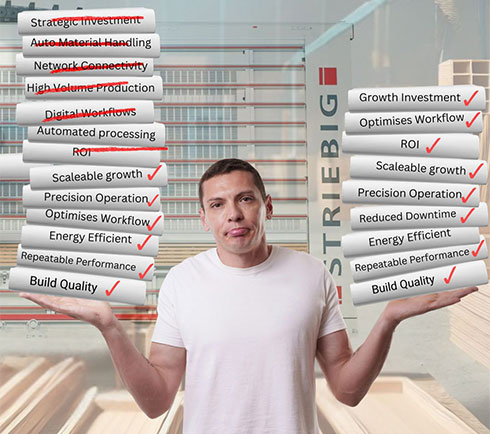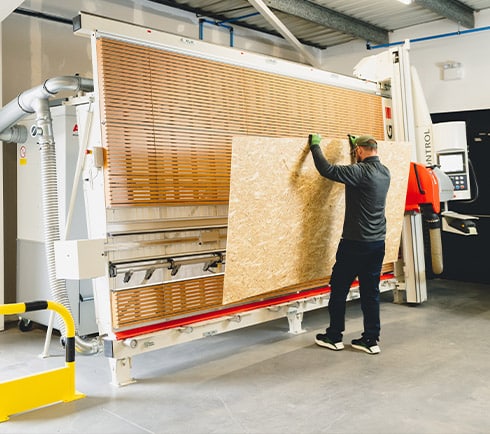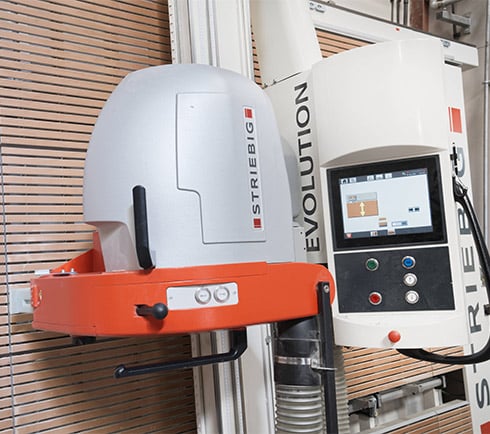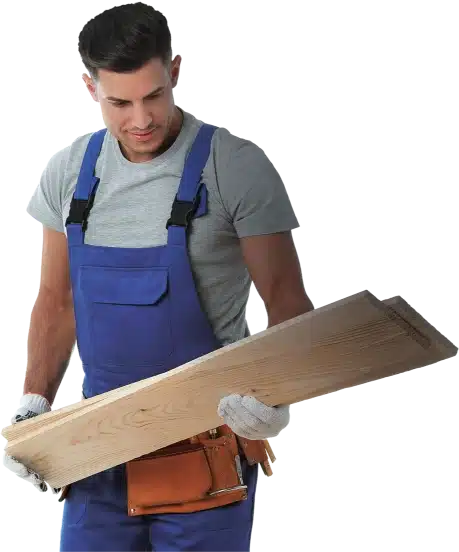Investing in high-quality woodworking machinery is crucial, but it’s easy to be tempted by extra features you may not need. From small joinery workshops to large-scale furniture manufacturing, managing costs and ensuring profitability in a growing market has never been more important or challenging.
Top-of-the-line machines boast impressive features, but they might not align with your business goals or budget. When it comes to woodworking machinery, the right machinery supplier will focus on your specific needs, the suitability of the machine for your applications, and long-term sustainable growth. That “top of the range machine” might have lots of appealing extras, but it isn’t always the best fit.
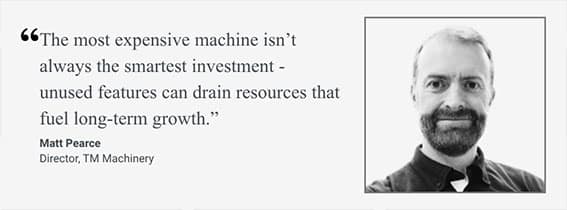
1. Top-of-the-Range Machinery Can Be Overkill for Your Needs
Investing in top-of-the-range machinery can be overkill if it exceeds your production requirements. While high performance ensures consistent and precise production, those extra advanced capabilities come with higher costs. If you don’t need complex features for your current operations, there’s little benefit to paying for them.
A good example is the Striebig Control Vertical Panel Saw, offering intelligent automation features — including real-time production data integration and customisable feed and cutting speeds. It’s impressive. But if you’re not going to benefit from this level of advanced technology, either now or in the foreseeable future, it’s going to put an unnecessary dent in the budget. A wiser choice could be the Striebig Compact – the same precision cutting and build quality, in a smaller, cost-effective model perfectly suited to the smaller output.
2. Why a Smart Investment Isn’t Always the Most Expensive One
Premium machinery from trusted brands offers outstanding precision, performance, and build quality — all critical when investing in new equipment for your business. And when established manufacturers invest heavily in engineering and innovation, it makes sense that their ranges include the latest automation and smart technologies. As a result, top-of-the-range models typically feature advanced capabilities designed to streamline workflows, enhance accuracy, and integrate with digital production systems. For any woodworking business, the potential is exciting — but that level of innovation comes at a cost that isn’t always justified by your production needs.
While focusing your budget on a major investment may be the next logical step, over-investing in a top-tier model could limit your ability to spend in other crucial areas such as staff training, marketing, or workspace improvements — all of which play a vital role in long-term business growth.
That’s why a strategic investment approach is essential. The goal isn’t to avoid innovation — it’s to invest at the right level to support your current production and growth plans. With advice from a reputable machinery supplier, you can invest in the most suitable yet cost-effective machine – and that isn’t necessarily the top-of-the-range model. That means choosing a sustainable, cost-effective solution now, while still leaving room to scale as demand increases.
3. Energy Efficiency is Often Overlooked in High-End Machinery
It’s not just the job at hand that’s impacted by your choice of woodworking machinery. Future goals and production flexibility all form part of the equation, but with long-term running costs, it pays to place energy efficiency high on the priority list. That top-of-the-range model may have all the bells and whistles, but that doesn’t always guarantee energy savings.
Focusing on the right machinery brand — and one that puts energy efficiency on an equal playing field to performance — could pay real dividends long term.
Take dust extraction – a legal requirement that could be contributing to unnecessarily high energy bills, with up to 40% of your annual consumption. By opting for machinery manufacturers that understand the importance of energy efficiency, you could significantly reduce those hefty bills and unnecessary expenses.
Consider the German AL-KO range of dust extractors, combining premium engineering with intelligent, energy-saving design. With optimised fan housings and high-efficiency IE3 or IE4 motors delivering up to 97% energy efficiency, these units can reduce dust extraction’s share of your energy consumption to as little as 2–10%. In today’s market – with increasing focus on sustainability – if energy efficiency isn’t near the top of the spec sheet, it’s not truly top of the range.
4. Top-tier Machinery May Not Provide the Customisation You Need
When making a significant investment, a top-of-the-range, off-the-shelf machine can seem like the obvious choice — especially if you’re unsure which features you’ll actually need in the future. It feels safer to have every option available. But in practice, that approach can end up costing more than it delivers. While customisable machinery is often seen as a premium option, customer-focused brands offer flexibility across their entire range — not just in flagship models. That means you can fine-tune your machine to suit your output, floor space, and goals — investing in what you’ll actually use, and nothing you won’t.
Think of woodworking machinery like a new car: the top-tier model comes loaded with extras, many of which go unused. A well-specified model with the right upgrades often delivers far better value. Whether it’s sawing solutions or tailored dust extraction units, choosing machinery built around your real-world needs reduces waste, improves workflow, and helps navigate staffing challenges – so you can focus on what really matters: quality, efficiency, and scalability.
5. Woodworking Machinery Can Limit Flexibility and Impact Your Production
In many traditional workshops, individual machines are used for specific tasks. While this approach manages immediate production needs, it can quickly limit operational adaptability when your workload becomes more varied, space is tight, or staffing isn’t always consistent. Sometimes, choosing the right machine means stepping away from top of the range thinking altogether, and focusing instead on the impact of flexibility. That means choosing machinery that doesn’t just deliver task-specific performance but actively supports your full workflow.
When you prioritise flexibility, you’re investing in the ability to adapt — not just the ability to perform a single task well. This shift in thinking can make all the difference in how efficiently your workshop runs and how prepared you are for changing production demands.

Take a top of the range sliding table saw. It might be seen as the go-to cutting solution, and digital controls and precision adjustment features will significantly improve accuracy — but this type of setup also demands considerable floor space, manual handling, and a high level of operator input. A top of the range sliding table saw could be a great choice if you have no plans to grow or change your setup. However, if order volumes increase or production flexibility becomes essential, the extra demands on time, space, and operator input can mean that even a premium saw starts to limit your ability to respond to changing market needs.
A vertical panel saw may be a wiser investment. While still a dedicated cutting machine, it’s designed to save space, reduce manual handling, and increase efficiency — especially when working with full-size panels. Quick to set up and highly repeatable, it delivers precision cutting under tight timeframes.
By focusing on the right machine — and choosing equipment with broader capability and flexibility rather than assuming the top-of-the-range model is always the best option — you could see a much better return on investment. The right machine doesn’t just improve cutting processes; it helps you increase throughput, boost accuracy, reduce operational costs, and streamline your workflow — all without overextending your team or your budget.
6. Top of the range Machinery Could Cost More Than You Think
Consider the long-term viability of your investment. A top-of-the-range machine may offer cutting-edge technology today, but if you won’t benefit from it in the foreseeable future, industry advancements could render it outdated sooner than expected.
Opting for a premium mid-range machine with less bells and whistles but the same high-level build-quality and precision, could deliver better long-term value.
Top of the range models are invaluable when looking to optimise high out-put manufacturing, but if you don’t need those advancements, it can put unnecessary strain on budgets.
7. Why Brand Recognition Doesn’t Always Mean the Best Machine
Brand recognition can be reassuring — but it isn’t a guarantee of superior performance or the right fit for your business. Many lesser-known manufacturers have been quietly building high-quality woodworking machinery for decades, prioritising engineering precision and practical innovation over big marketing budgets.
What matters most is how well a machine performs in your setting. That means looking beyond the logo and assessing build quality, features, support, and suitability.
So how can you be confident in choosing the right machinery for your woodworking business?
This is where the right supplier really earns their keep. A reputable machinery partner will have already done the legwork – researching and curating brands based on long-term reliability and performance.
Many of the most trusted machines come from specialist companies that started by solving real workshop problems – not building big marketing campaigns. And many come from Europe. Look to those carefully selected recommendations from countries known for advanced engineering and high-performance woodworking machines, like Germany, Switzerland and Italy.
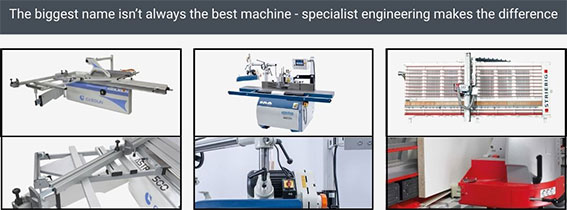
Take Casolin, for example.
An established Italian manufacturer of sliding table saws, spindle moulders, sanders and planers, Casolin has been designing high-quality machinery since 1969. Like many of the best woodworking businesses, they’ve grown by adapting to the market while staying true to what matters: consistently delivering quality, precision and reliability in every product they build.
And while Striebig might not be the first name that comes to mind when you think of general woodworking machinery, in precision panel cutting, it’s a global benchmark.
Their machines are trusted worldwide for accuracy, reliability, and durability — not just in woodworking, but also in plastics and composite processing. Striebig began with a single machine, built by founder Ludwig Striebig to solve a problem in his own workshop. That same problem-solving mindset still shapes their range today — tackling real workshop challenges and anticipating the demands of modern production.
Now a globally recognised Swiss brand, Striebig has earned its reputation through decades of specialist focus, engineering excellence, and advanced machines built for long-term use in real-world workshops and factories – not just to impress on a spec sheet. Casolin and Striebig are not alone – brands like Panhans share the same specialist engineering focus, prioritising precision, build quality and long-term reliability to meet specific workshop needs.
In the end, it’s not about the biggest name – it’s about the right machine, built to deliver where it counts. Big-name brand or not, that means proven performance, consistent quality, and the confidence that your investment will support your next steps — not just your current needs.
So, once you’ve looked past the brand — how do you make the right investment?
Investing in High-Quality Woodworking Machinery: Avoiding Unnecessary Features
The best investments aren’t always the most expensive. A quick Google search for the “best woodworking machine” will probably lead you straight to the most expensive, feature-packed models on the market. But that doesn’t mean they’re the right choice for your workshop or factory – or your business goals.
Choosing the right machinery isn’t about going top-of-the-range by default. It’s about finding the equipment that fits your workflow, supports your team, and stands up to the demands of your production — without overcomplicating things or overspending.
What matters most is investing in machinery from brands that deliver consistent performance, precision, and reliability across their entire range – not just in one flagship model. That kind of consistency builds trust, streamlines maintenance, and keeps production running smoothly.
For some businesses — particularly high-output operations focused on lean manufacturing — a top-tier machine with advanced automation might be the perfect fit. But for many others, the smarter choice is a well-engineered, less feature-laden model that offers the right level of flexibility and delivers reliable value day after day, without paying for extras you don’t need.
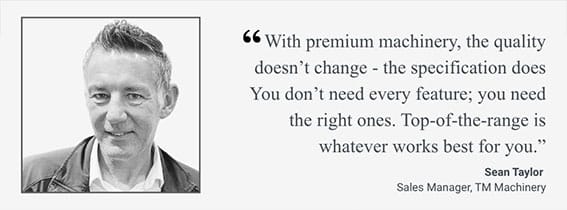
A reputable machinery supplier won’t just push the most expensive model — they’ll help you choose equipment that genuinely fits your operation.
By partnering with the right team, you can make a confident investment that supports efficient production and long-term growth, tailored to your specific needs.
At TM Machinery, we often say: “You focus on what you do best – we’ll focus on helping you get there.” Whether you’re planning a single upgrade or a long-term investment, it starts with the right advice — and the right machine.
Ready to make a smarter investment?
With over 30 years of experience in the woodworking industry, our team offer expert advice to support your manufacturing goals. We provide the highest quality machinery brands and provide an exceptional aftercare and maintenance service.
To find out how we can help you choose the right woodworking machinery contact the team at TM Machinery.
